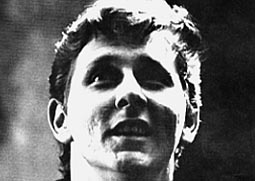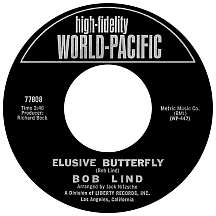BOB LIND
Elusive Butterfly
"Elusive Butterfly" has a flowing lyric more poetic than musical, though it's set to a lovely melody. Bob Lind rejected the opinion of its being an abstract love song and has said he wrote it about the thrill of the chase, relishing the process of working toward a goal, no matter how challenging: '...it's only me pursuing something I'm not sure of...across my dreams with nets of wonder...I chase the bright elusive butterfly of love' surely suggests the difficulty of achieving something worthwhile. The song, conveying softly-hued early-morning twilight imagery, eschews the pop music practice of rhyming lines (other than the odd pairing of 'sure of' and 'of love') and is open to interpretation on nearly every line ('You might have seen me runnin' through the long-abandoned ruins of the dreams you left behind...'). Timing was right for Lind's idyllic mini-opus; it was a major hit in early 1966.
Bob was an Air Force "brat," born in Baltimore but regularly forced to move because of his stepdad's military commitment. The constant change of scenery and awkward process of making, then leaving behind, new friends in schools fueled a creative urge to write songs about life's pleasures and, moreso, disappointments. By the time he entered high school, his family had settled in Denver, Colorado. As of his 18th birthday, in 1960, he had already been writing songs for several years; acoustic guitar flung over his shoulder, he set out to establish himself in local folk music circles. For a time he led his own band, Bob Lind and the Misfits, a name designed to describe how he saw himself.
A few years at Western State University in Gunnison, Colorado, some 200 miles from Denver, were spent skipping class so that he could play guitar, write songs, chase women and, basically, goof off; by 1963 he was playing live at popular Denver nightspots (including the Green Spider and the Exodus Club) frequented by the beat crowd (Judy Collins had established herself on the same turf a few years before). Some of his live performances were casually recorded by Analyst Coffeehouse owner Al Chapman, Bob's biggest supporter during his time on the Colorado music scene. When he set out for San Francisco in 1965, Bob took along a tape of four of the best songs. A few months later he headed to Los Angeles. In the summer of 1965 he took the tape to Richard Bock of World Pacific Records (an offshoot of the Pacific Jazz label Bock had started 13 years earlier) and was offered a contract, no muss, no fuss, no struggle. The timing couldn't have been better, folk-rock being at the peak of its powers that year (Bob Dylan, The Byrds, Barry McGuire, We Five and oodles more scoring hits) as America's answer to the previous year's dominance of British acts.
Jack Nitzsche, one of the busiest record guys in L.A. (he had worked with Phil Spector during the peak "Wall of Sound" phase of '63-'64), had made his own instrumental records for Reprise ("The Lonely Surfer" was a top 40 hit) and written lots of songs ("Needles and Pins," penned with Sonny Bono, had been a hit for Jackie DeShannon in '63 and The Searchers a year later). A regular fixture at Liberty Records' studios by '65, he was assigned to produce Lind's first recordings. Nitzsche merged Lind's poetic compositions with mainstream pop productions more in line with what he'd done during his time with Spector and with other artists, going so far as to use many of the same session musicians (Spector's so-called "Wrecking Crew"). Lind, always critical of his work, wasn't pleased with the finished take of "Elusive Butterfly," not because of Nitzsche's arrangement but because the lyrics weren't so good (that was his opinion, anyway). World Pacific put it on the flip side of "Cheryl's Goin' Home," a stronger track, or so they thought. Besides, the label credited Bock as producer and Nitzsche as arranger, but Jack claimed he did it all...so what did it matter?

Released in the fall, "Cheryl" didn't make much progress, then near year's end the inevitable happened: a disc jockey in Florida flipped the record over, listeners reacted immediately, and before long stations everywhere were playing the song Lind didn't like. "Elusive Butterfly" debuted on the national charts in January 1966 and reached the top ten in March. The single broke in England at about that time with a cover by Val Doonican right behind it. Both singles entered the U.K. top ten in April. Don't Be Concerned, taken from the lyrics of the hit, became the title of Lind's album (he and Nitzsche had become close friends; Jack jabbed him in the album's liner notes: "...without a doubt, the worst pool player I have ever known"). Another LP, The Elusive Bob Lind, suddenly appeared on the Verve Folkways label; a tape of acoustic recordings made in Denver a couple of years earlier had come into the label's possession (no one's quite sure if the supplier was Bob's old pal Al Chapman) and the tracks were remastered with additional instruments; two singles were also released that year by Verve.
The title of the hit single's follow-up, "Truly Julie's Blues," isn't anywhere in the lyrics, a tricky proposition for anyone who wanted to buy the record (though Dylan pulled off the trick with "Rainy Day Women" at the same time); "I'll Be There" was added as a subtitle to ease confusion. The lyrics, as with many of his songs, suggest something deeply personal. Flip side "Remember the Rain" (it was included on his second album) also received airplay. Each spent a short time on the charts. It seemed Bob Lind was the hot new songwriter of '66; "Elusive Butterfly" was recorded by quite a few artists while others dug deeper. San Diego group The Cascades (that "Rhythm of the Rain" gang) released a cover version of "Cheryl's Goin' Home" that saw a little chart movement (they were obvious fans; "Truly Julie's Blues" is on the flip side). The Turtles featured one of his songs, "Down in Suburbia," on their second album, You Baby. "Mister Zero," which he had written after his girlfriend (that would be Julie, the implied subject of the previous single) broke up with him (due in part to his heavy drinking and downer attitude), leaving him feeling "worthless," was recorded by The Yardbirds' lead singer Keith Relf for release as a solo single. It hit the U.K. charts in May. Adam Faith jumped on the bandwagon with yet another version of "Cheryl," which hit the British charts in the fall of '66.
A second World Pacific album was recorded almost immediately. Photographs of Feeling, released during the summer, featured "San Francisco Woman," an ode to the "hippie chicks" Bob had known during his brief stay in the Bay Area. A livelier track (with kazoo!), it showed promise, but media outlets seemed to have moved on and had little interest in supporting it. Before long it was obvious to those around him that Lind had a serious problem with alcohol and drug use; he later admitted he was difficult to work with, arrogant to friends and business acquaintances, caught up in his ego and seriously in need of a life adjustment. "Goodbye Neon Lies" had a bigger, brass-backed arrangement and was his last single for World Pacific in early 1968. He moved to the small town of San Jose, New Mexico, basically disappearing from view until returning to Los Angeles in 1971. Capitol Records took a chance with him, releasing an album, Since There Were Circles, and a single, "She Can Get Along." Though it wasn't a big seller, many of his fans consider it his best work. Since then, Bob Lind has moved to Boca Raton, Florida and switched gears, writing novels, stage plays and a screenplay, Refuge, which took first place in the 1991 Florida Screenwriters' Competition. Sometimes he even writes and records poetic folk songs.


